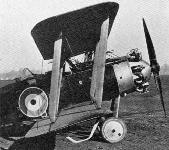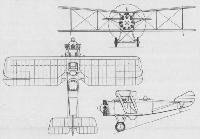
Описание
Страна: Великобритания
Год: 1918
Fighter
D.James Westland aircraft since 1915 (Putnam)
Weasel
During the final months of the 1914-18 War the Air Ministry was already giving thought to its postwar aircraft requirements and preparing some detailed specifications. Among these was RAF Type IIIA for a two-seat fighter-reconnaissance aircraft. It was intended as a replacement for the highly effective Bristol F.2B Fighter - the 'Brisfit' - which was still a comparatively new design having entered service with the Royal Flying Corps in April 1917. The Type IIIA specification called for a much improved performance, particularly in the time-to-height and service ceiling; however, the armament remained the same as the F.2B, being two fixed forward-firing guns and one gun on a Scarff ring mounting in the rear cockpit. The most unfortunate aspect was the preferred use of the ABC Dragonfly engine, a nine-cylinder radial engine designed, like the earlier Wasp which powered the Wagtail, by Granville Bradshaw. The Dragonfly proved to be a disaster in almost every way. It was claimed to produce 340 hp and weigh 600 lb but never, at any stage, delivered more than 295 hp and weighed 656 lb; moreover, it rapidly overheated having what was described as 'probably the worst example of air cooling in a production aircraft engine’. Of most importance was its designed running speed which happened to be the critical torsional vibration frequency of the crankshaft which regularly broke after a few hours running.
It was around the Dragonfly that three manufacturers designed and built prototypes, in various quantities, to meet the Type IIIA requirement. They were the Austin Motor Co which produced the Greyhound, Bristol Aeroplane Co with the Badger and Westland which scaled up its earlier single-seat Wagtail to create the two-seat Weasel.
Designed by Robert Bruce and Arthur Davenport, the Weasel was of similar construction to the Wagtail having a wooden girder type fuselage of rectangular cross-section with spruce longerons and spacer struts, the latter being tapered to fit into square steel cups bolted to the longerons. This structure was internally wire braced. Forward of the front cockpit the fuselage was plywood covered with fabric covering on the remainder; however, a small rectangular area on each side of the observer' cockpit was left uncovered to provide a 'window'. The strut-braced tail unit, which had the Westland-patented variable-incidence tailplane gear, was of similar wire-braced wooden construction and also was fabric covered. The engine mounting ring was carried on an extension of the longerons which was internally wire braced, while the complete nose section of the fuselage had removable metal panels to provide access to the engine and to the fuel and oil tanks. The engine's cylinder heads protruded through holes in the nose cowl and the Dragonfly turned a 9 ft 9 in diameter two-blade fixed-pitch wooden propeller. The fabric-covered two-bay biplane wings were built up around two ash spars with cross-braced drag struts and three-ply cut-out ribs with spruce flanges. The eight interplane struts were of streamline section spruce and, like the four centre-section support struts, were all wire cross-braced. Constant-chord ailerons were fitted to each of the four wings. As in the Wagtail, although the centre-section was smaller in span, there was an angular cut-out in its trailing edge and in that of the lower wings' trailing edge; in addition five ribs were omitted in the centre-section aft of the main spar leaving an uncovered opening above the pilot's cockpit. The two fixed forward-firing synchronised Vickers .303 in machine-guns were carried in troughs in the top of the front fuselage, with provision for one, or two, Lewis guns of similar caliber to be carried on a Scarff ring mounting in the observer's cockpit. Spruce V main undercarriage legs with a cross-axle having enclosed bungee rubber shock absorbers were used with a tailskid. A wind-driven generator was mounted on the port rear main leg. An unusual visual feature of the Weasel was the manner in which the upper and lower wings appeared to be splayed away from each other; in fact, the upper wing had 5 deg dihedral from the flat centre-section while the lower wing had no dihedral. Oxygen bottles with some 3 hours supply for the two crew and electrical heating equipment were carried in the fuselage.
An order for three Weasel prototypes was placed in April 1918 with construction starting almost immediately, but forthcoming events cast their shadows over the work with the first of a number of delays in delivery of the engine. In 'the event the war was ended when the first Weasel, serialled F2912, was flown for the first time by Capt Stuart Keep during late November 1918.
Preliminary flight trials were punctuated by continuous problems with the engine, both on the ground and in the air. One incident, which could have had serious results for Westland, occurred when Stuart Keep was flying the Weasel with Robert Bruce in the observer's cockpit and the engine failed a long way from the aerodrome. Bruce immediately leaned out of the cockpit and cranked the starter magneto which was fitted on the starboard side of the fuselage, but the Dragonfly refused to start. Fortunately, the Weasel had sufficient altitude to glide back to the aerodrome, brushing through the top of the boundary hedge en route to a dead-stick landing. While company trial with this first prototype continued into the early months of 1919, construction of the second and third aircraft proceeded at a steady pace. During May F2912 went to the AEE at Martlesham Heath for 'airframe and Dragonfly motor' tests. These included some handling checks during which the lateral control was criticised. Meanwhile, as a result of the failures of the Dragonfly, it was decided to replace it with a 350 hp Armstrong Siddeley Jaguar II engine, the first airframe to be modified being the third prototype F2914 which went to Martlesham Heath during June 1922. Among airframe modifications was the fitting of horn-balanced ailerons and rudder.
While construction of the second and third Weasels had been proceeding, in August 1919, Westland received an order for a fourth aircraft to be powered by a Jaguar II. By this time all development testing of the disastrous Dragonfly had been abandoned and the production of military aircraft cut to a trickle; thus, Westland was aware that a production order for Weasel was unlikely to be placed. Nevertheless, flying with the four prototypes continued at Yeovil and at Martlesham Heath, at which latter location the Weasels made appearances until November 1924, when F2914, the third prototype was there. During November 1919 F2912, the first prototype, caught fire in the air while allegedly powered by an Armstrong Siddeley Lynx; however, it pilot, Flt Lt A H Orlebar, managed to sideslip to the ground and crash land where the fire was extinguished, the aircraft being written off charge in the following March.
By mid-summer of that year, all the Weasels had been handed over to the Royal Aircraft Establishment at Farnborough where they were being used for flight testing engine and various equipment. Although this work may have appeared mundane compared with operational flying, there was the interest of fitting and flying, in J6577, the exciting new Bristol Jupiter II radial engine which, in September 1921 was the first engine to pass the Air Ministry's type-test by delivering 400 hp at 1,625 rpm. However, there were installation problems, particularly with the Jupiter' valve gear which not only had some teething problems with its push rod which had automatic compensation for cylinder expansion, but also proved vulnerable to icing which topped the engine when tested in climbs to altitude during the winter month. To overcome this latter snag the RAE made some wind-tunnel investigations with a number of different shaped 'helmets' to fit over the Jupiter's exposed cylinder heads, and later test flew the Weasel with this modified cowling. There were moment of glory too, the first on 24 June, 1922, when the Jupiter-powered Weasel appeared in the New Types Park at the third Royal Air Force Pageant at Hendon. However, on 11 July J6577 caught fire in the air while at AEE, crashed and burnt out. F2914 was a 'New Type' at Hendon on 30 June, 1923, but, with F2913, flew at the RAE until written off charge in 1925 and 1924 respectively.
Description: Two-seat biplane fighter. Wood/metal construction with fabric, wood and metal covering.
Accommodation: Pilot and observer/gunner in open cockpits.
Powerplant: One 340 hp ABC Dragonfly nine-cylinder air-cooled normally-aspirated radial engine driving a 9 ft 9 in diameter two-blade wooden propeller (F2912). One 350 hp Armstrong Siddeley Jaguar II fourteen-cylinder two-row normally-aspirated air-cooled radial engine (F2912 and F2914). One 400 hp Bristol Jupiter II nine-cylinder normally-aspirated air-cooled radial engine (F2913 and J6577).
Armament: Two fixed synchronised Vickers .303 in forward-firing machine-gun in troughs in the top of the front fuselage with Aldis and ring-and-bead sights, and one, or two, Lewis .303 in machine-gun on a Scarff mounting in the rear cockpit.
Dimensions: Span 35 ft 6 in; length 24 ft 10 in; height 10 ft 1 in; wing area 36 sq ft.
Weights: Empty 1,626 lb; loaded 3,046 lb.
Performance: Maximum speed 120 mph at sea level; landing speed 56 mph; service ceiling 22,100 ft.
Production: Four Weasel built by Westland Aircraft Work, Yeovil, Somerset, during 1918-19.
Описание:
- D.James Westland aircraft since 1915 (Putnam)
- P.Lewis The British Fighter since 1912 (Putnam)
- F.Mason The British Fighter since 1912 (Putnam)
- W.Green, G.Swanborough The Complete Book of Fighters
- J.Bruce British Aeroplanes 1914-1918 (Putnam)
- H.King Armament of British Aircraft (Putnam)
Фотографии
-
D.James - Westland aircraft since 1915 /Putnam/
The second Weasel, F2913, shows off its neatly cowled Jupiter engine and wide-span wings, the apparent splaying of which is an optical illusion.
-
J.Bruce - British Aeroplanes 1914-1918 /Putnam/
Westland Weasel with A.B.C. Dragonfly engine.
-
D.James - Westland aircraft since 1915 /Putnam/
This view of F2913 shows the large aperture in the upper centre-section, the cut-away wing roots and the generous size of the rudder and elevators.
-
P.Lewis - British Racing and Record-breaking Aircraft /Putnam/
The Westiand Weasel J6577 with Bristol Jupiter II engine, flew on 24 June, 1922, in the Handicap Race during the RAF Pageant at Hendon.
-
F.Mason - The British Fighter since 1912 /Putnam/
The fourth and final Westland Weasel, the Mk II, J6577, with horn-halanced ailerons, enlarged fin and muffs on engine exhaust pipes.
-
H.King - Armament of British Aircraft /Putnam/
Westland Weasel two-seat fighter, showing pilot's fixed Vickers guns and installation of Scarff ring-mounting.
-
D.James - Westland aircraft since 1915 /Putnam/
Thi retouched photograph of the Weasel's structure reveals a full-chord wing root without a cutout. The pilot's basket-work seat is noteworthy, as are the neat decking around the cockpit and the Scarff ring.
-
W.Green, G.Swanborough - The Complete Book of Fighters
Designed to succeed the Bristol F.2B, the Weasel failed to attain production.









